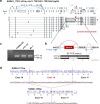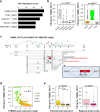Dissection of molecular and histological subtypes of papillary thyroid cancer using alternative splicing profiles
- PMID: 35277656
- PMCID: PMC8980103
- DOI: 10.1038/s12276-022-00740-0
Dissection of molecular and histological subtypes of papillary thyroid cancer using alternative splicing profiles
Abstract
Despite growing evidence of the relevance of alternative splicing (AS) to cancer development and progression, the biological implications of AS for tumor behaviors, including papillary thyroid cancer (PTC), remain elusive. With the aim of further understanding the molecular and histological subtypes of PTC, we in this study explored whether AS events might act as new molecular determinants. For this purpose, AS profiles were analyzed in RNA-sequencing data from The Cancer Genome Atlas (TCGA) and from a Korean patient dataset. A total of 23 distinct exon-skipping (ES) events that correlated significantly with PTC oncogenic activity and differentiation scores were identified. The two top-ranked ES events, NUMA1_17515 in exon 18 of NUMA1 and TUBB3_38175 in exon 6 of TUBB3, showed high correlations with oncogenic activities and discriminated histological and molecular subtypes of PTC. Furthermore, two novel intron-retention (IR) events for TUBB3 were uncovered. All ES and IR events for the TUBB3 gene were predicted to induce nonsense-mediated mRNA decay. The relative abundances of intron reads in the PTC dataset from TCGA showed IR levels to differ significantly among PTC subtypes, possibly reflecting their different tumor behaviors. This study provides a landscape of AS changes among PTC subtypes and identified two significant AS events, NUMA1_17515 and TUBB3_38175, as potential AS biomarkers for PTC subclassification and characterization. The AS events identified in this study may be involved in the development of phenotypic differences underlying the functional characteristics and histological differentiation of PTCs.
© 2022. The Author(s).
Conflict of interest statement
The authors declare no competing interests.
Figures






References
-
- Cabanillas ME, McFadden DG, Durante C. Thyroid cancer. Lancet. 2016;388:2783–2795. - PubMed
Publication types
MeSH terms
LinkOut - more resources
Full Text Sources
Medical
Research Materials
Miscellaneous

